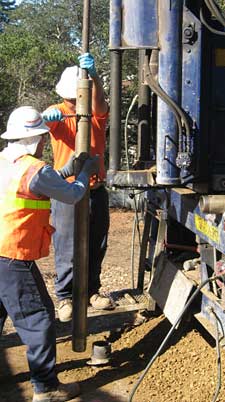SAHPC site was never a burial ground, consultants confirm
Archaeological study, now complete, finds no indication site was ever used for that purpose by area's Native Americans
| 21 January 2009
 View of crewmembers removing casing containing sample soil.
View of crewmembers removing casing containing sample soil. BERKELEY — An extensive geoarchaeological investigation has found no evidence of prehistoric Native American artifacts or human remains beneath the construction site for the campus's new Student-Athlete High Performance Center.
The full report on the investigation's findings was released on Jan. 8 by William Self Associates, a leading consulting firms on matters related to archaeological and historical preservation.
The report's findings support the conclusions of the firm's earlier, comprehensive review of California state records and archival material, which found no substantive indications that unique or important prehistoric artifacts or human remains exist beneath the construction site.
The geoarchaeological exploration of the construction site adjacent to the western wall of California Memorial Stadium began Sept. 21. Work crews spent more than three weeks extracting 31 soil core samples from every sector of the site. The depth of each core — ranging from 15 to 50 feet — was based on an evaluation of existing historical records, geological conditions, and the anticipated depths of construction impacts. A Native American monitor from the Ohlone tribe was on site every day to observe the drilling and ensure that if cultural artifacts or Native American remains had been discovered, they would have been treated in accordance with the law and tribal traditions.
"Although the university was not required to conduct an archaeological investigation of this nature or scope, we were asked to perform a very extensive exploration for a site of this size," said William Self's James Allan, supervising archaeologist on the project. "While our initial, in-depth archival research found little evidence to support the idea that this site contained Native American cultural material or human remains, we can now say with confidence that there is not an ancient burial ground beneath the site of the Student-Athlete High Performance Center."
According to Allan, there is still a possibility that items left behind by 19th-century residents of the homes that once lined the eastern side of Piedmont Avenue may still be found on the site. Likewise, as is true of any area associated with a natural watercourse, indications of prehistoric activity may also be discovered in other areas of the site as project-related excavations proceed. However, no evidence of such resources was identified in the geoarchaeological testing. The university will have professional archaeological monitors on site during the excavation phase of the construction project to address the discovery of any previously unknown archaeological resources that might be encountered in the course of construction.
The Student-Athlete High Performance Center will provide training, medical, and academic facilities for more than 400 student-athletes, coaches, and staff members associated with 13 of Berkeley's 27 intercollegiate teams. Construction is expected to be completed and the building ready for occupancy in the summer of 2011.
Review the full geoarchaeological report submitted by William Self Associates.

